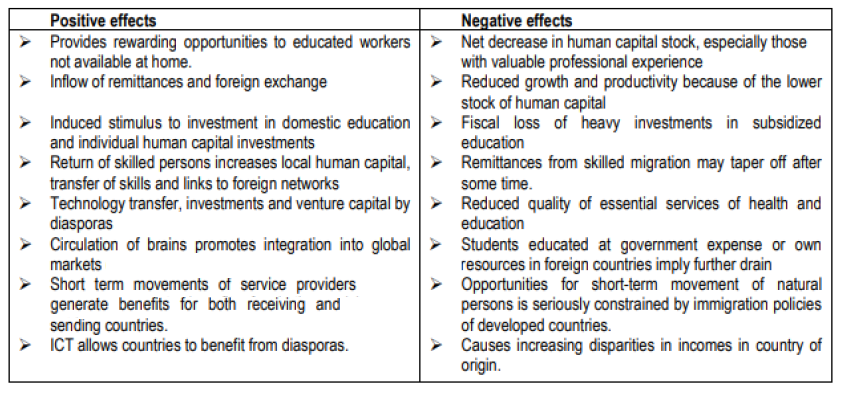Migration and Brain Drain from India
2023 DEC 31
Mains >
Society > Globalisation > Employment
Syllabus
GS 1 > Indian Society > Globalisation, Employment
REFERENCE NEWS
- A chartered plane from the UAE to Nicaragua was grounded in France for a human trafficking probe. The flight, which was carrying 303 Indians, was finally forced to return to Mumbai.
- Mahesh Langa reports on how those from Gujarat, frustrated by the lack of opportunities, travel abroad, especially to the U.S. and Canada, by hook or by crook, even if it means risking their lives.
WHAT IS "BRAIN DRAIN"?
- Brain drain occurs when educated, professional workers leave a country to move elsewhere where they can benefit from better pay, working conditions, lifestyle, and sometimes work-life balance.
REASONS FOR BRAIN DRAIN
Overseas University Education:
- The Indian education system, despite progress in primary education, struggles at the higher education level with institutions like IIT and IIMs not ranking among the world's top universities.
- This leads to dissatisfaction among students, who feel unprepared for global challenges, and a lack of innovative courses further drives young students to seek education overseas.
- Ex: reports indicate that over half of the top students in Class 10 and Class 12 exams between 1996 and 2015 pursued studies or careers abroad, primarily in the US.
Low Expenditure on R&D:
- India's gross domestic expenditure on research has stagnated at around 0.7% of GDP, one of the lowest ratios among BRICS nations.
- This lack of investment in research motivates students interested in R&D to migrate abroad for better opportunities.
Lack of Higher Education Opportunities:
- High cut-offs and numerous competitive exams in India limit access to higher education. In contrast, Indian students often have an edge in skills and knowledge abroad.
- Additionally, insufficient educational institutes relative to the growing population, coupled with privatization and higher tuition fees, prompt students to seek education in other countries.
- Ex: The Ukraine-Russia conflict highlighted the trend of Indian medical students obtaining affordable education in post-Soviet countries.
Lack of Employment Opportunities:
- Unemployment, particularly among educated individuals, is a significant factor. As of December 2021, one in five Indian college graduates was unemployed,
- According to the Center for Monitoring Indian Economy, many Indians migrate for better job prospects, pay, and work hours, especially in high-demand fields like healthcare and STEM in countries like the US and UK.
Better Remuneration and Standard of Living:
- Developed countries offer higher pay and better living standards, attracting young professionals from India.
- The disparity in income and quality of life between India and these countries is a major reason for emigration.
Immigrant-Friendly Policies:
- Nations with low populations and a shortage of skilled workers, such as Australia, New Zealand, Germany, Japan, Italy, and other EU countries, have been attracting Indians with streamlined immigration processes and friendly policies.
- For instance, Australia has introduced more immigrant-friendly policies across Federal, State, and Regional levels.
Societal Pressure:
- The increasing liberal and individualistic mindset of Indian youth often clashes with the traditional societal norms in India.
- This mismatch drives many to seek out western countries where society is more liberal and non-interfering. The pressure to conform in Indian society is a significant factor in encouraging youth to emigrate.
EFFECTS OF BRAIN DRAIN:
-------------------
GOVERNMENT INITIATIVES TO TACKLE BRAIN DRAIN FROM INDIA:
- The Ramanujan Fellowship:
- Ramanujan Fellowship is meant for brilliant Indian scientists and engineers from outside India to take up scientific research positions in India, those Indian scientists/engineers who want to return to India from abroad.
- The Ramalingaswamy Fellowship:
- The idea behind starting Ramalingaswami Re-entry Fellowship in 2006-07 was to attract high quality Indian brains working abroad to pursue their research interests in life sciences, biotechnology and other related areas in India by providing them an attractive avenue to pursue their R&D interests in Indian institutions.
- Vaishvik Bharatiya Vaigyanik (VAIBHAV) summit:
- The VAIBHAV initiative aims to bring out the comprehensive roadmap to leverage the expertise and knowledge of global Indian researcher for solving emerging challenges. By bringing the Indian Overseas and Resident academicians/scientists together a structure of association will be evolved.
- Innovation in Science Pursuit for Inspired Research (INSPIRE):
- The basic objective of INSPIRE would be to communicate to the youth population of the country the excitements of creative pursuit of science and attract talent to the study of science at an early stage and build the required critical human resource pool for strengthening and expanding the Science & Technology system and R&D base.
WAY FORWARD:
- Diverse Sector Opportunities: Develop job opportunities in education, women empowerment, agriculture, and handicrafts. Emulate Germany's integration of skilled workers across various sectors, including manufacturing and renewable energy.
- High-Tech Industry Incentives: Offer competitive packages in pharmaceuticals, electronics, and ICT to retain recent graduates. Follow South Korea's model of investing in technology sectors to attract skilled workers.
- Taxation Reform: Simplify the taxation system and ensure efficient use of taxes to encourage professionals to stay. Look towards Singapore's business-friendly taxation as a benchmark.
- Enhanced Work Culture: Improve work culture by addressing office politics and communication gaps. Adopt Finland’s approach of high-quality work-life balance and employee-friendly policies.
- Attracting NRIs: Create technological opportunities and incentives to attract Non-Resident Indians back to India. Use the United States as a model for creating an ecosystem that attracts and retains top talent.
Addressing these complex issues requires a multifaceted approach that goes beyond policy reform. It necessitates community engagement, awareness programs, and international cooperation to tackle the root causes of migration and provide sustainable solutions.
PRACTICE QUESTION
Q: What are the factors propelling illegal Migration from India?Suggest some measures to address this crisis?(15M, 250W)
